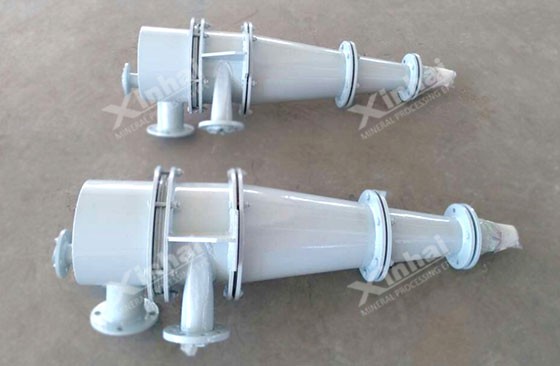

Warm Tip: If you want to know more details about equipment, solutions, etc, please click the button below for free consultation, or leave your requirements!
The hydrocyclone was invented in 1891 and began to be used for concentration and desilting in 1935. When it was introduced to the United States in 1948, it had a modern structure. However, China began to test and apply it in the early 1950s.

At present, the development characteristics of hydrocyclone technology and application are gradually expanding, including: specification enlargement, structure and type diversification, application range enlargement, wear-resistant material diversification, and so on.
In the late 1950s, the smallest cyclone with a diameter of 10mm appeared, most of which were dozens or hundreds of such microtubules assembled in a cylindrical box for uniform feeding and uniform discharge of overflow and sedimentation, and used for ultra-fine grading and sorting operations. In the 1980s, the diameter of the largest cyclone reached 1500mm, while in the 1990s, the Soviet union made a cyclone with a diameter of 2000mm, and the British and Swedish company Sala made a cyclone with a capacity of 2,100m3 / h and 2,400 m3 / h, respectively.
The structure and type change of hydrocyclone is mainly to improve the probability of high score and reduce energy consumption, and can adapt to different USES. Local structure improvement, the cyclone cone from a single taper into different cone Angle of the multi - cone or multi - cone multi - cylinder combination, also have convex type, this will help improve the classification efficiency; Cylinder made with spiral grooves or gradually increased diameter type; The feeding tube is changed from simple tangential connection to involute connection or helical connection to advance centrifugal separation. It can reduce the turbulence of local circulation in the annular region and save energy.
The traditional application field of hydrocyclone is solid liquid separation, including grading, concentration, dehydration, desilting, sand removal, washing and so on. It has been extended to the separation of solid catalysts by liquefied coal gas, separation of red blood cells from plasma, recovery of residual fibers from pulp waste liquid and so on. Solid solid separation, a large number of ore separation, but also used to remove impurities from the powder, starch and protein separation, etc. Liquid liquid separation, used for the separation of crude oil and water in oil fields, used for the separation of extraction fluid in chemical plants; Liquid gas separation, for oil and gas field oil, water, gas separation.
The initial swirl inner wall with ceramic, silicon carbide or cast stone lining, to enhance the wear resistance. Later, the inner lining is made of silicon carbide, silicon nitride, cermet and high alumina ceramics. But these material price are relatively expensive, wear-resistant rubber material appeared again in recent years do lining, because the wear-resistant material of high-performance often is on the high side of the price, so, often be in the different wear-resistant part of cyclone, line on different wear-resistant material, will reduce the cost of the product.
The design and production of a hydrocyclone requires a certain product to maintain a certain concentration, purity or loss limit. However, due to the nature of the material cannot guarantee the stability, so it is necessary to adjust at any time and develop the automatic type immediately. In the production, the adjustable items of the accessory cyclone include feed pressure, feed concentration, grit diameter and overflow diameter. The adjustment method of these parameters is to change the feed pump revolution, adjust the outlet pressure and flow, adjust the grit diameter with the pneumatic pump, adjust the overflow pipe diameter with the pneumatic valve, change the feed concentration through the feed liquid (or add water).
The technology and application of hydrocyclone have been developing in three directions: improving classification efficiency, reducing energy consumption and realizing automatic control.
The above are the 5 aspects of the development of hydrocyclone. Up to now, hydrocyclone is still expanding in the field of mine application, has been extended to tailings treatment, tailings damming, tailings pre-concentration, tailings enrichment recovery, tailings filling and other operations.
1Influence of Hydrocyclone Structure on Classifying Effect
 8
8
 4381
4381
2How to Improve Your Hydrocyclone Efficiency?
 0
0
 3965
3965
3Development of Hydrocyclone
 2
2
 3845
3845


What Are the Differences Between CIP and CIL?
 11491
11491
 0
0